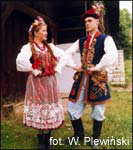
In present-day Poland about sixty folkloristic regions are recognized, each with their own specific traditional costumes. In some areas, like Podhale, Kurpie, Opoczno and Sieradz, the tradition still lives and the costumes are still made and worn at holidays. Many other regions don't have a living tradition. The costumes are still made, but mostly for dance-ensembles and choirs. In some regions the traditional costumes had to be reconstructed from paintings, museum collections and written accounts.
The Polish traditional costumes are characterized by a very colorful presentation and a great diversity. Every costume has variations (sometimes very small), often containing information about for instance the town of origin, being married or not and wealth. Nowadays it not always clearwhat function certain details have (had).
Some properties of the costumes are more or less common. In Mazowsze and central Poland the lines and color stripes of the womens' costumes are running vertically. In the south-east these are running horizontally. In the west of Poland the men wear their shirts in their trousers, while the men from the east wear their wide shirts over their trousers with a certain belt. The size of this belt is tells how high from the mountains the man originates.
The most famous costume is that of Krakow. Therefore it is often seen as a national costume. Almost every beginning folk ensemble starts with this costume. Unfortunately it is no longer part of the living folklore. Source
If you're interested in other traditional or historical dress or costumes from all over the world, check out The Costumer's Manifesto.



 ShareThis
ShareThis
